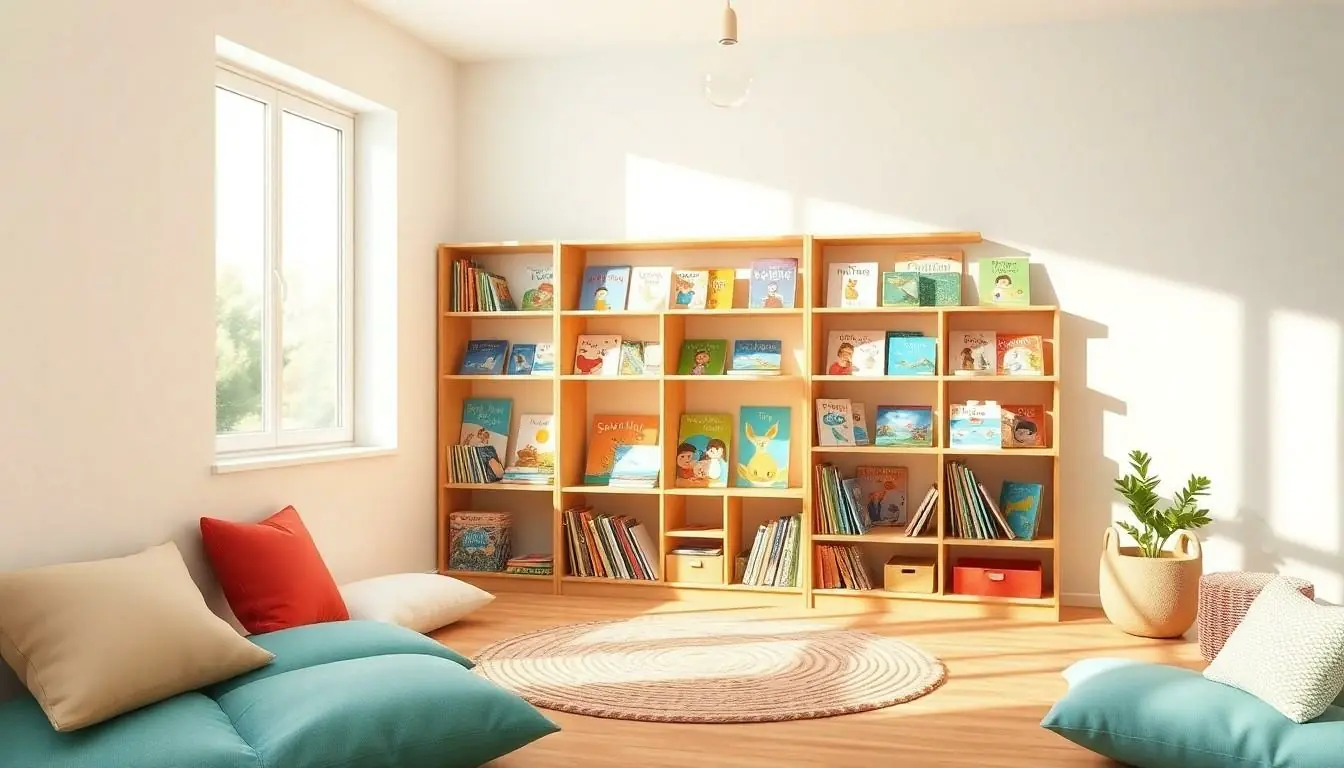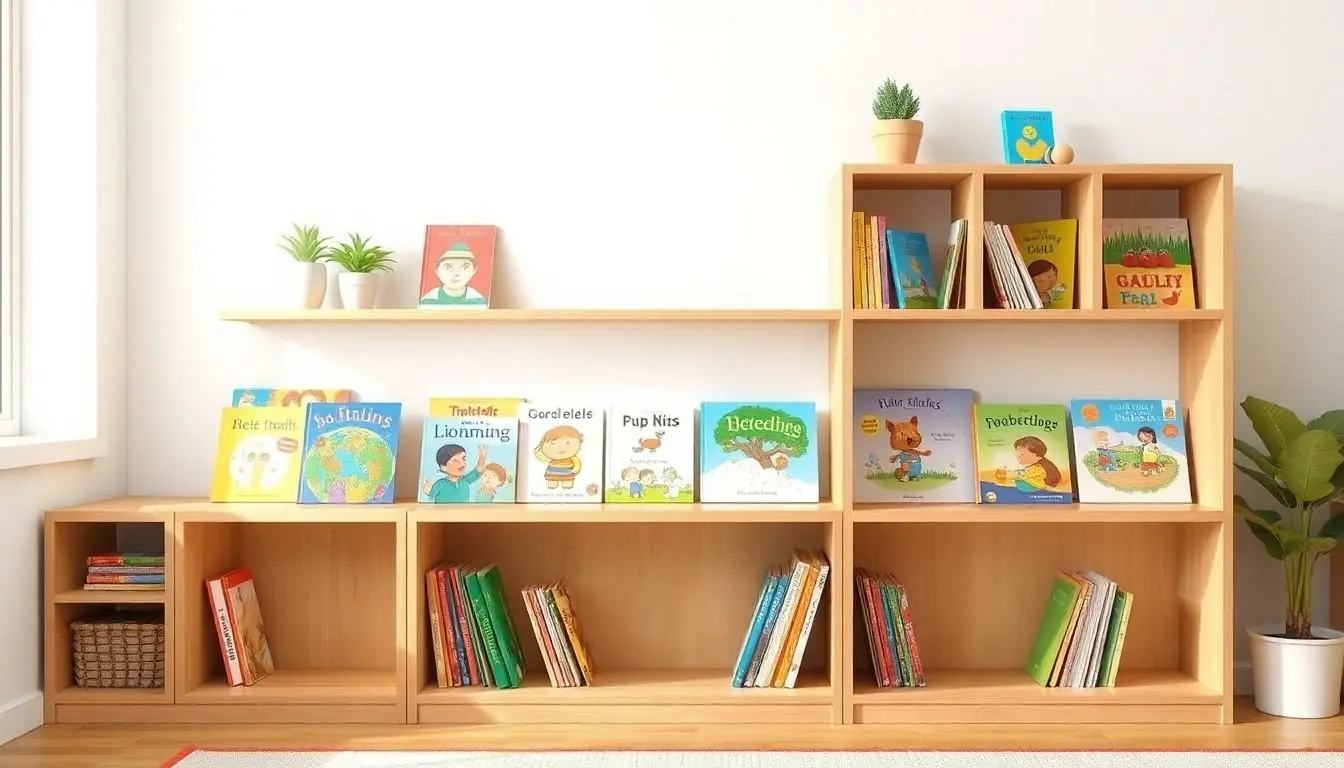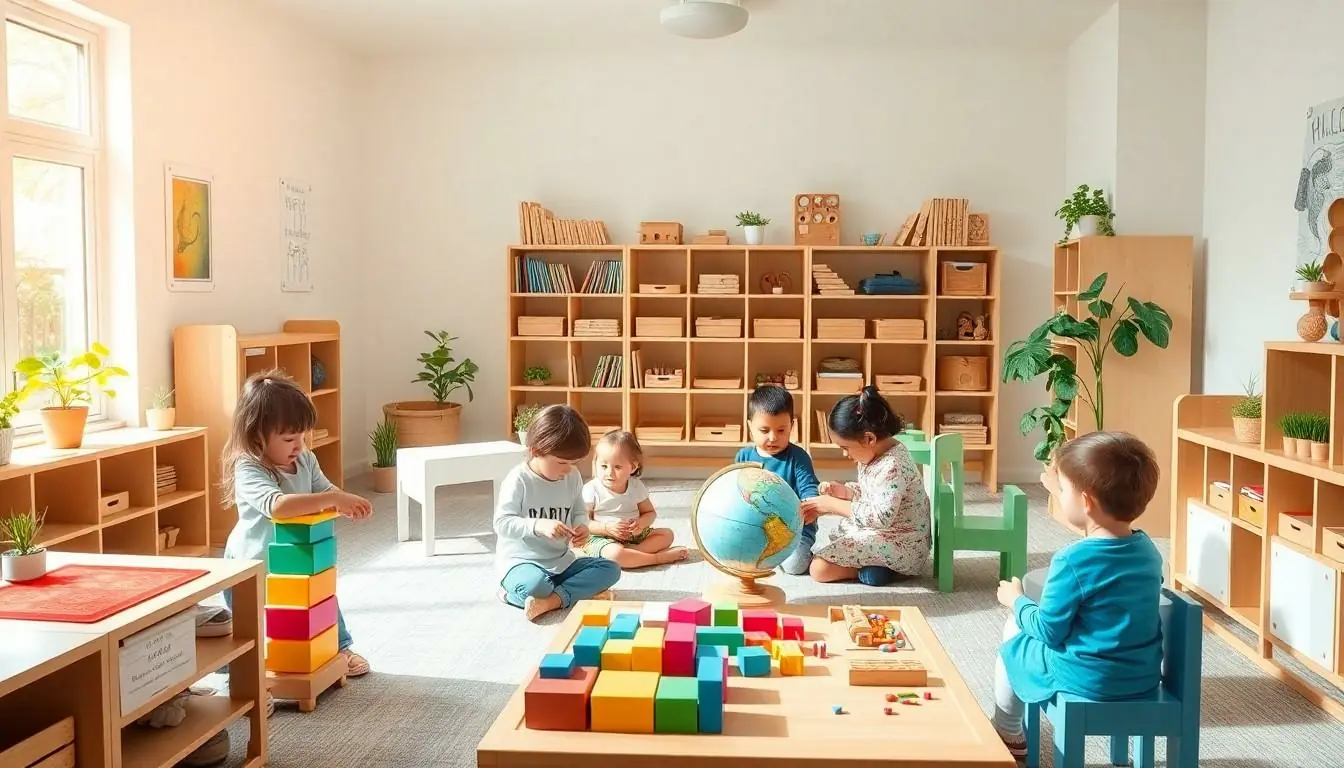A Montessori bookcase isn’t just another piece of furniture – it’s a gateway to adventure that transforms any child’s room into a magical reading sanctuary. These low-level, forward-facing shelves make books irresistible to little explorers while teaching independence and fostering a lifelong love of reading.
Unlike traditional bookcases that tower over tiny humans, Montessori-style shelving puts literature right at a child’s eye level. It’s like creating a mini library where toddlers can be their own librarians, selecting and returning books without calling for backup from mom or dad. This simple yet brilliant design has been capturing young minds and organizing children’s rooms since Maria Montessori first introduced her revolutionary educational approach.
Table of Contents
ToggleWhat Is a Montessori Bookcase
A Montessori bookcase features front-facing shelves positioned at child height with open access to book covers. Each shelf displays books with covers visible allowing children to see the full front of each book.
These specialized bookcases include:
- Forward-facing display rails that show book covers
- Low height shelving accessible to toddlers ages 2-6
- Open shelf design without doors or barriers
- Sturdy construction for safety during child use
- Multiple tiers for organizing different book sizes
The physical dimensions typically follow these specifications:
| Feature | Measurement |
|---|---|
| Height | 24-36 inches |
| Shelf Depth | 4-6 inches |
| Width | 24-48 inches |
| Space Between Shelves | 8-12 inches |
Key design elements distinguish Montessori bookcases from traditional shelving:
- Books face outward rather than spine-out
- Shelves sit lower to the ground
- Children access materials without adult assistance
- Limited book capacity prevents overwhelming choices
- Minimalist aesthetics reduce visual clutter
The storage capacity accommodates 15-25 books depending on shelf configuration. Reading materials rotate regularly to maintain engagement while preventing overstimulation from too many choices. The streamlined design enables independent book selection fostering autonomy in young readers.
Key Features of Montessori Bookcases
Montessori bookcases incorporate specific design elements that support child development and independence. These features align with Montessori educational principles promoting autonomy and engagement in young learners.
Forward-Facing Display
Forward-facing book displays showcase book covers instead of spines, creating visual appeal for children ages 2-6. Each shelf includes a front rail that holds books at a 75-degree angle, making covers fully visible. The display accommodates 4-6 books per shelf with 2-3 inches of space between each book. This arrangement helps children recognize familiar titles through cover art and promotes independent book selection. Forward-facing storage reduces visual overwhelm and maintains organized presentation of reading materials.
Child-Height Accessibility
Low-level shelving positions books at 24-36 inches from the ground, matching a child’s natural eye level and reach. Each tier measures 8-12 inches apart vertically, enabling easy access to different book sizes. The base shelf sits 4-6 inches off the floor, creating stability for toddlers learning to stand and select books. This ergonomic design empowers children to browse independently without adult assistance.
Simple and Organized Design
Clean lines and minimal ornamentation define the Montessori bookcase aesthetic. The open shelf configuration eliminates doors or drawers that could impede access. Each shelf spans 24-48 inches in width with 4-6 inches of depth, providing space for systematic book organization. The streamlined design includes 3-5 tiers for categorizing books by theme, size or reading level. Premium materials like solid wood or sturdy composites ensure durability for daily use.
Benefits of Using a Montessori Bookcase
Montessori bookcases create an enriched learning environment that supports child development through purposeful design features. These specialized shelving units provide multiple advantages that align with Montessori educational principles.
Promoting Independence
A child-height Montessori bookcase empowers children ages 2-6 to select reading materials without adult assistance. The front-facing display enables young readers to identify book covers instantly while the open shelf design lets them return materials to designated spots. Children develop organizational skills by maintaining their personal library space through the 15-25 book capacity limit. The accessible height of 24-36 inches allows toddlers to reach books safely without climbing or straining. This autonomy in book selection builds confidence through repeated successful interactions with the shelving system.
Encouraging Reading Habits
Forward-facing book displays capture children’s attention by showcasing vibrant cover artwork at eye level. The 4-6 inch shelf depth presents books within easy reach while maintaining visual order. Regular rotation of 15-25 titles keeps the selection fresh without overwhelming young readers with choices. The 8-12 inch spacing between shelves accommodates various book sizes from board books to picture books. This thoughtful organization system creates an inviting reading environment that draws children to explore books independently throughout the day.
How to Set Up Your Montessori Bookcase
Setting up a Montessori bookcase creates an inviting reading environment that encourages independent exploration. The setup process focuses on two key areas: thoughtful book selection and strategic placement.
Book Selection and Rotation
Book selection starts with choosing 15-20 age-appropriate titles for display. Picture books with clear illustrations work best for ages 2-4, while early readers suit ages 4-6. Rotating books every 7-10 days maintains children’s interest and prevents overstimulation. Books fall into three categories:
- Seasonal selections reflecting current weather, holidays or activities
- Educational materials matching current learning themes
- Favorite stories children return to repeatedly
Mix fiction and non-fiction titles in a 60/40 ratio. Include books with varying difficulty levels to support reading development. Store extra books in a separate location to facilitate easy rotation.
Optimal Placement Tips
Place the bookcase against a wall away from high-traffic areas to create a calm reading zone. Position it where natural light falls on book covers without causing glare. Essential placement guidelines include:
- 24-inch distance from adjacent furniture for easy access
- 36-inch clearance in front for comfortable browsing
- Eye-level height alignment for target age group
- Direct line of sight from play areas
- Soft cushions or child-sized seating
- Reading lamp for adequate lighting
- Small rug to define the space
- Storage basket for book rotation
Best Materials and Styles to Consider
Selecting appropriate materials and styles for a Montessori bookcase ensures durability, safety and aesthetic appeal in a child’s reading space. The right combination of materials and design elements creates an inviting environment that encourages independent exploration.
Wood vs. Other Materials
Solid wood stands as the premier material choice for Montessori bookcases due to its durability and natural aesthetics. Premium hardwoods like maple, oak or birch provide stability and resist daily wear from active toddlers. Bamboo offers an eco-friendly alternative with similar strength characteristics to traditional hardwoods. Medium-density fiberboard (MDF) with non-toxic finishes presents a budget-friendly option, though it lacks the longevity of solid wood. Metal components introduce safety concerns for young children, while plastic materials often fail to support heavier books effectively. Natural wood finishes allow children to connect with authentic materials while withstanding years of use.
Size and Storage Options
Standard Montessori bookcases feature 3-4 display tiers measuring 24-48 inches in width. Each shelf accommodates 5-8 picture books when displayed cover-forward. Compact models measuring 24 inches wide suit small spaces while providing storage for 15-20 books. Larger units spanning 48 inches accommodate 25-30 books across multiple tiers. Corner units maximize space efficiency in square rooms. Wall-mounted rails offer supplemental display options for rotating seasonal selections. Freestanding units include stabilizing back panels that prevent tipping. Storage cubbies beneath display shelves create dedicated space for oversized books or reading accessories.
Conclusion
A Montessori bookcase stands as a powerful tool in nurturing early childhood development and fostering a lifelong love of reading. Its thoughtful design empowers young minds through accessibility independence and organized learning spaces.
When parents invest in a quality Montessori bookcase they’re not just buying furniture – they’re creating an environment that supports their child’s natural curiosity and desire to learn. With proper setup and regular maintenance these bookcases become centerpieces of childhood literacy and development.
The combination of forward-facing displays child-height accessibility and strategic organization makes the Montessori bookcase an essential element in any child’s learning journey. It’s an investment that continues to deliver value throughout a child’s early years.




